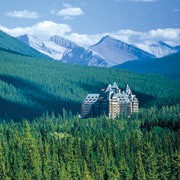Flanked by towering granite mountains, glaciers, forests, alpine meadows, lakes, and rivers, Banff can bank on its natural assets alone. Banff National Park, along with nearby Jasper, Yoho and Kootenay national parks, comprise much of the UNESCO Canadian Rocky Mountain Parks World Heritage Site, one of the largest protected areas in the world.
“The Canadian Rockies are probably the most recognizable thing other than the Canadian flag we have in Canada, and Banff is at the heart of the Canadian Rockies,” says John Stutz, mayor of Banff and also a true native son, having been born in the town. “Other parks have beauty, but they don’t have the mystic quality or majesty Banff has. I often describe it as Canada’s town. It’s in a national park, so all Canadians feel some ownership. I get e-mails every week, from Vancouver to Halifax, all advising me how to run Banff.”
Over a century ago, when three railroad workers stumbled on the hot springs on the side of Sulphur Mountain, the site barely registered a blip on Canada’s radar. But change came quick for this Rockies locale. Just a year later Canadian Pacific Railroad Director Lord Steven renamed the town Banff after his birthplace, Banffshire in Scotland. In 1887, the reserve was initially dubbed Rocky Mountain Park, the first in Canada’s national park system.
In 1888 the Canadian Pacific Railway Company built the area’s first significant tourist accommodation, The Banff Springs Hotel, now a Fairmont property. Stutz pegs the transformation of Banff from small-town retreat to major tourist destination on the hotel’s decision in the ’60s to stay open year-round.
“That’s when we really started to emerge as a world-class destination in winter and summer,” Stutz recalls.
In the ’70s, swarms of Japanese visitors poured into Banff, reaffirming its global appeal.
“We became quite aware we were a world destination,” Stutz says.
Today, skiers flock to Banff’s three ski resorts, Sunshine Village, Ski Norquay and nearby Lake Louise Mountain Resort, while in summer hiking, biking and boating on Lake Louise produces a steady wake of visitors. The town’s famed Banff Upper Hot Springs, with an alpine backdrop, are open year-round, and the Banff gondola on Sulphur Mountain sports views of six mountain ranges.
“One of our most visited attractions is the gondola lift,” Stutz says. “I was born here and I was just up last week. It’s something I’ve always marveled.”
Aside from its natural assets, Banff also claims bragging rights to a wealth of upscale amenities comparable to full-fledged cities, namely with its top-tier restaurants, lodges and arts community. The Banff Centre stands at the helm of that community, focusing on performing, literary, new media, and visual arts programs and presentations, culminating in the annual Banff Summer Arts Festival.
“The Banff Centre is one of our internationally recognized institutions, a center for artistic and cultural excellence,” Stutz says.
There is a $120 million renovation taking place over the next few years, as the center attempts to reinvent its look and increase its international recognition.
Downtown also recently received an upgrade, including expanded sidewalks and green space, to become what Stutz calls Canada’s most recognizable main street, with Cascade Mountain in the background.
“We’ve gone from idyllic mountain town to one of the world’s most renowned destinations,” Stutz says. “We’re very proud of that.”







